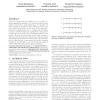Free Online Productivity Tools
i2Speak
i2Symbol
i2OCR
iTex2Img
iWeb2Print
iWeb2Shot
i2Type
iPdf2Split
iPdf2Merge
i2Bopomofo
i2Arabic
i2Style
i2Image
i2PDF
iLatex2Rtf
Sci2ools
KDD
2006
ACM
2006
ACM
Aggregating time partitions
Partitions of sequential data exist either per se or as a result of sequence segmentation algorithms. It is often the case that the same timeline is partitioned in many different ways. For example, different segmentation algorithms produce different partitions of the same underlying data points. In such cases, we are interested in producing an aggregate partition, i.e., a segmentation that agrees as much as possible with the input segmentations. Each partition is defined as a set of continuous non-overlapping segments of the timeline. We show that this problem can be solved optimally in polynomial time using dynamic programming. We also propose faster greedy heuristics that work well in practice. We experiment with our algorithms and we demonstrate their utility in clustering the behavior of mobile-phone users and combining the results of different segmentation algorithms on genomic sequences. Categories and Subject Descriptors: F.2.2 [ANALYSIS OF ALGORITHMS AND PROBLEM COMPLEXITY]: N...
ALGORITHMS AND PROBLEM | Data Mining | KDD 2006 | Nonnumerical Algorithms | Sequence Segmentation Algorithms |
| Added | 30 Nov 2009 |
| Updated | 30 Nov 2009 |
| Type | Conference |
| Year | 2006 |
| Where | KDD |
| Authors | Evimaria Terzi, Panayiotis Tsaparas, Taneli Mielikäinen |
Comments (0)

